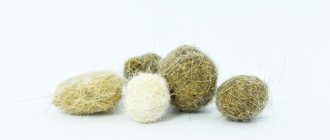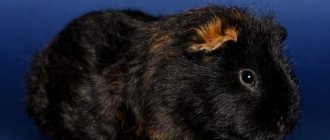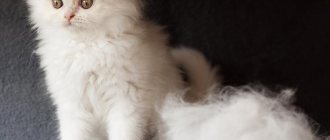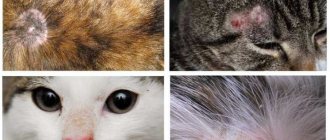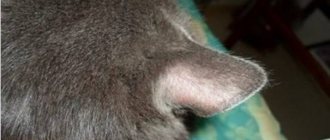Alopecia, or feline hair loss: what is it?
All cats shed twice a year, and this is the norm. How to distinguish: is it molting (the process when the fur is renewed) or pathology (baldness of the animal)? To do this, you need to know how the disease manifests itself, what its prerequisites are and in what cases the owner needs to sound the alarm.
Alopecia is the name given to abnormal hair loss in cats, as a result of which bald spots are formed on the animal's body - areas with absolutely no hair. The fur may fall out in clumps, forming bald areas on the animal's head, ears, and paws. Having noticed such areas, the owner should immediately take the pet to an appointment with a veterinarian. Baldness can be a signal of serious problems in the animal’s body.
But this should not be confused with hair loss, which normally occurs in all healthy felines. Cats lose their fur during:
- molting (a seasonal change of “coat” occurs twice a year; cats usually shed more than males);
- stress (the animal may shed some hair due to excitement);
- age-related changes (old animals lose hair and whiskers);
- frequent bathing (this is why it is recommended to bathe the animal only if necessary; twice a year is quite enough).
At the same time, the wool does not come out in clumps, without forming bald spots. But the disease has slightly different symptoms.
Healthy coat and lack thereof
The second name for baldness is alopecia. The pathology is manifested by abundant hair loss of the pet, the formation of bare areas - bald spots. In a healthy state, cat fur is soft, shiny, silky, and the hairs fit tightly together.
Cats have fur replacement year-round. During certain periods, the shedding of hairs increases and the density of the fur decreases significantly - this is molting. If the shedding cat’s health is normal, there are no pathological formations on the skin, the nose is moist and cold, and the appetite is good, then there is no reason to worry.
Lack of hair can be congenital and not associated with pathology. The peculiarity is detected from 4 months of age and cannot be treated.
By origin, alopecia is:
- symptomatic – associated with a specific pathology;
- idiopathic - an independent disease.
The source of baldness varies:
- diffuse – the fur comes out abundantly and evenly;
- localized – a certain area of the skin goes bald;
- partial – bald spots appear in different places.
When a cat tears at itchy skin with its claws, infection can enter the wounds and an inflammatory process will begin.
Common types of hair loss in cats
An analysis of the location of bald spots on the cat’s body and the condition of the skin helps to make a rough diagnosis.
| pathology | symptoms |
| dermatological diseases | uniform baldness of the trunk and limbs |
| hormonal imbalances | the cat's tail at the base, chest, nose, hips goes bald, the skin becomes inelastic |
| thyroid pathology | fur grows abundantly on the neck, chest, belly, and pelvic area |
| stress | the cat begins to itch intensely, the back, inner thighs, belly, limbs, and anus go bald |
| avitaminosis | the body begins to become covered with medium-sized naked spots of a round shape, usually merging, the skin in the lesions turns red |
| oncological pathologies | large bald spots cover the lower body, belly, limbs, complete loss of hair is possible |
| fungal infection | In bald areas, cracking and peeling of the skin is observed |
Alopecia symptoms
You can recognize alopecia in a pet by the following signs:
- The fur falls out excessively, in clumps. Bald spots in cats appear mainly behind the ear, in the neck, back, and on the tail.
- The skin in these places may have its usual pink color or turn red, sores or scabs may appear there.
- Check your pet's reaction to touching the bald spot: perhaps the spot hurts or itches.
- Check if the animal has symmetrical bald spots.
If you notice these symptoms, you should urgently seek professional help from a veterinarian. Otherwise the disease will progress.
Pathological causes of baldness
Diseases and pathological conditions in which hairless spots appear on a cat are divided into contagious and non-contagious.
The list of individual diseases and treatment methods differ, so separate sections are allocated to describe them.
Contagious diseases:
Most often, the occurrence of alopecia is a symptom of the following diseases:
- Ringworm: this is the name given to a group of diseases that cause patches of baldness. In most cases, hair and skin are affected by pathological fungi. Micromycetes are found everywhere; they can live on a cat’s fur and skin for years without harming it. But when the body’s defenses are weakened, fungi begin to actively multiply. At risk are children whose immune system has not yet developed, as well as older people whose immune system has already degraded. The disease is unsafe for humans, especially young children and the elderly. If you suspect lichen, you should contact a veterinarian, who will make an accurate diagnosis and prescribe treatment.
Be sure to read:
How dangerous are ulcers in a cat’s mouth, and how should they be treated? And when should you worry about a cat’s life?
The kitten has lichen
- Activity of external parasites: fleas, lice eaters. Flea saliva causes irritation. The skin becomes inflamed and hair falls out. Lice eaters feed on wool, so the infested cat loses its hair and alopecia appears. Treatment and prevention consists of applying Spot-on drops to the skin or treating with insecticidal aerosols.
- Subcutaneous mites: Demodex or Notoedrus. Hairless lesions appear on the affected areas. Notoedrus can attack humans and cause itchy dermatitis. Treatment consists of using external insectoacaricides prescribed by a veterinarian. To speed up hair regrowth, veterinary feed or medicinal feed additives are used.
- Helminths: the pathological effect of worms is twofold. The waste products of helminths enter the skin and cause irritation. Dermatitis develops, resulting in hair loss. Parasites are in dire need of biologically active substances for their own consumption. Therefore, they block the absorption of vitamins from the intestines. Hair follicles, deprived of biological catalysts, cease to form hairs. Treatment and prevention consists of deworming, as well as diet correction.
Insectoacaricide, which is applied to the withers, protects against fleas, ticks, and worms
Causes of this disease
If an animal has bald spots on its body and head, this may be a sign of a food allergy. Allergies should be looked for in your pet's diet. They can be:
- Proteins of animal and plant origin;
- Various cereals;
- Meat – in particular lamb.
In addition, it may be an allergic reaction to flea bites, cigarette smoke or other odors (inhalation allergy).
The causes of baldness may lie in the psychological state of the pet, that is, hair may fall out due to stress. If the veterinarian diagnoses this reason, then the first thing the owner needs to do is find out what kind of stress or experience the pet has had recently, eliminate it, and only after that give sedatives, which only in this case will be effective. Symptoms of alopecia of a psychogenic nature are bald patches that are located on the thighs, abdomen or paws.
The causes belonging to the third group are infectious. If a cat's hair is falling out, the culprit may be scabies, lichen, fungus, or mites. If a cat has a bald spot behind its ear, it could be ringworm. There are several varieties: fungal (another name is ringworm; contagious to humans), psoriasis or eczema, viral.
Hair mites can also cause hair loss. They are very small and impossible to notice with the naked eye. Lice eaters do not live long, but they reproduce very quickly.
If your cat has bald spots on its neck, the cause may be dermatitis. It can be caused by various chemical and biological factors. Even treatment for parasites can cause hair loss.
Hair loss can be a consequence of seborrhea, a disease in which the functioning of the sebaceous glands is disrupted. This is usually indicated by baldness in a cat near the tail. That is why this disease is sometimes called “greasy tail”.
Another group of problems that cause baldness is disruption of the hormonal system:
- thyroid problems, manifested by both increased and insufficient levels of hormone production;
- diabetes;
- malfunctions of the adrenal glands, in particular their hyperfunction.
Other reasons include the presence of tumors in the animal, genetic predisposition and reactions to medications. Thus, a kitten’s bald spot may appear due to the fact that during pregnancy its mother did not receive various essential minerals and vitamins.
Non-communicable diseases
The following unfavorable factors of non-contagious etiology lead to the formation of alopecia:
- Unbalanced feeding: in economy class feeds, as well as feed mixtures from natural products, there is not enough building material and biological catalysts for the formation of hairs and maintaining skin health. Therefore, veterinarians recommend using ready-made food of at least premium class. To prepare a feed mixture from natural products, the cat owner needs to acquire the skills of preparing diets. Uncontrolled use of vitamin supplements leads to poisoning and hair loss.
- Allergic reactions: there are allergies to food components, external irritants - pollen, odors, accessories, household items. The fight against the disease consists of eliminating harmful factors. The veterinarian prescribes antihistamines, as well as professional hypoallergenic food.
- Stress: fright, moving, participation in an exhibition, the appearance of a new pet in the apartment. Leads to the loss of a significant part of the coat. Treatment and prevention consists of preventing stressful situations, as well as taking Stop-stress or Vetspokoin medications.
Be sure to read:
How to understand that a cat is sick: external signs, how the animal behaves, clear signs of illness, what to do
Result of stress
- Hormonal imbalance: congenital or acquired abnormalities are associated primarily with hypothyroidism - insufficient secretion of thyroid hormones. In addition to symmetrical bilateral baldness, cold intolerance, obesity, and hair discoloration occur. The muzzle takes on a pained expression. Treatment consists of lifelong injections of thyroid hormones.
- Congenital pathologies - hypotrichosis and seborrhea. In the first case, babies are born with sparse hair, and by four months they lose the rest of their hair. Pets are constantly cold. No treatment has been developed. Seborrhea is an abnormality of the sebaceous glands. Inflammation develops, in which the hair follicles die along with the sebaceous glands. The most commonly known symptom is the greasy tail. Treatment is symptomatic.
Greasy tail
- Chemical and physical reasons: hair falls out due to unqualified treatment with anti-flea drugs, as well as exposure to overheating when the pet’s rookery is located near functioning heating radiators.
There are situations when a cat sheds all its hair at once for no apparent reason. Possibly, toxic substances enter and accumulate with food, water, and inhaled air.
The body tries to remove toxins from the body in every possible way. First, it directs them to the least valuable parts of the body - hair. When the concentration of toxins reaches a threshold level, hair rejection occurs.
Diagnosis of the disease
If a cat's hair falls out in clumps before bald spots form, it should definitely be seen by a specialist. Only a veterinarian can accurately determine the diagnosis. To determine the disease and prescribe the correct treatment, the doctor must:
- Find out how and when the disease manifested itself. The owner will have to tell in great detail the animal’s lifestyle, what the pet ate and drank, what it came into contact with, and whether it walked outside.
- Examine the patient.
- Examine hair roots under a microscope.
- You may need blood and hormone test data, and a scraping will be required.
- Sometimes an ultrasound or x-ray is done to confirm or rule out the presence of tumors.
Treatment of hair loss in cats
Hair loss in cats is a serious but completely treatable disease. Treatment must be selected individually. What medications the doctor will prescribe depends on the causes of the disease. If bald spots on the ears or other places appear due to allergies, the animal must first be isolated from the allergen. The doctor also prescribes drugs that stimulate the immune system and antiallergic medications. If there is a food allergy, you should review the animal’s diet and switch it to hypoallergenic foods.
If the cause of an animal's hair loss is parasites, the pet is treated with gel and ointment that have antiparasitic properties. In such cases, it is also recommended to give the pet drugs that stimulate the immune system.
If the bald spots were caused by an abscess, the animal must undergo a course of treatment with antibiotics and antiseptics. If a cat has been diagnosed with endocrine problems, she is prescribed hormonal medications.
Preventive measures
To prevent ear baldness in cats and hair loss on other parts of the body, it is recommended to take preventive measures in advance. Namely:
- regularly independently examine the animal, take it for professional examinations, and, if necessary, for treatment at the veterinarian;
- vaccinate your pet on time;
- do not forget about proper hygienic care of the cat;
- Provide your pet with proper nutrition.
Bald spots in cats on the head, ears, belly or paws are a fairly common phenomenon. Why a cat has bald spots on its back or other parts of its body - only a doctor can say for sure after conducting the appropriate diagnosis. Depending on this, treatment is prescribed, which can consist only of diet, or contain a course of hormonal drugs or antibiotics. But it is highly not recommended to self-medicate your pet: you can only torture the animal with unnecessary drugs, and in the meantime the cat will lose most of its fur coat.
Bald spots at first glance seem harmless, although they spoil the aesthetic appearance of the animal. But it should be understood that they can be provoked by quite serious diseases that develop in a pet. Therefore, you should not hesitate to visit the doctor.
Endoparasites
If you notice your pet constantly wanting to scratch a bare area, this may indicate the presence of endoparasites. For example, scratching with teeth or claws may occur in an animal due to unpleasant flea bites. In order to relieve the animal from unpleasant sensations, special solutions, sprays and drops for the withers are used. Treatment must be carried out several times in order to remove not only adult individuals from the fur, but also newly hatched larvae.
Of all the internal organs, the intestines are the most susceptible to parasite penetration. Antihelmintic drugs are excellent for removing worms from the body. However, if the case is advanced (for example, when infected with large worms), the cat may need surgical intervention.
You might be interested in: A cat was bitten by a tick: how to help your pet?
Ear mites can be treated with drops and proper care for your pet. You will need to remove him from contact with stray animals and prohibit him from eating rodents and wild birds.
